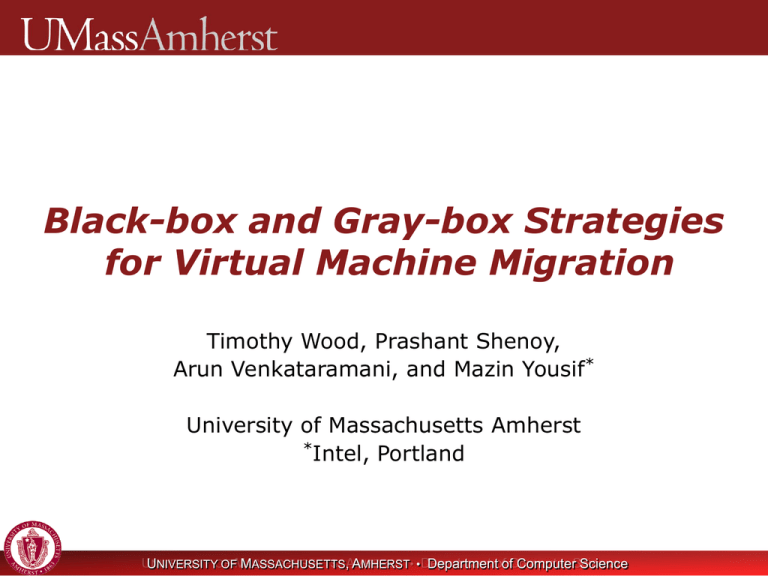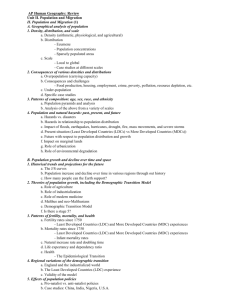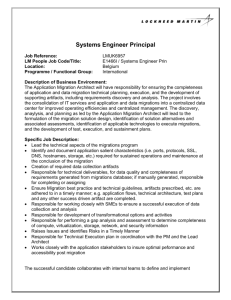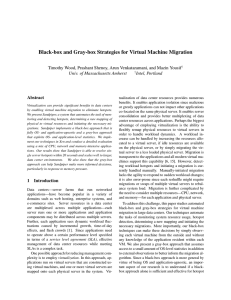Black-box and Gray-box Strategies for Virtual Machine Migration
advertisement

Black-box and Gray-box Strategies for Virtual Machine Migration Timothy Wood, Prashant Shenoy, Arun Venkataramani, and Mazin Yousif* University of Massachusetts Amherst *Intel, Portland UNIVERSITY OF MASSACHUSETTS, AMHERST • Department of Computer Science Enterprise Data Centers Data Centers are composed of: Large clusters of servers Network attached storage devices Multiple applications per server Shared hosting environment Multi-tier, may span multiple servers Allocates resources to meet Service Level Agreements (SLAs) Virtualization increasingly common Benefits of Virtualization Run multiple applications on one server Each application runs in its own virtual machine Maintains isolation Provides security Rapidly adjust resource allocations CPU priority, memory allocation VM migration “Transparent” to application No downtime, but incurs overhead How can we use virtualization to more efficiently utilize data center resources? Data Center Workloads Web applications see highly dynamic workloads 1200 0 0 1 2 3 Time (days) 4 5 Request Rate (req/min) per min Arrivals Arrivals per min Multi-time-scale variations Transient spikes and flash crowds 140000 120000 100000 80000 60000 40000 20000 0 0 5 10 15 Time (hrs) How can we provision resources to meet these changing demands? 20 Provisioning Methods Hotspots form if resource demand exceeds provisioned capacity Static over-provisioning Allocate for peak load Wastes resources Not suitable for dynamic workloads Difficult to predict peak resource requirements Dynamic provisioning Adjust based on workload Often done manually Becoming easier with virtualization Problem Statement How can we automatically detect and eliminate hotspots in data center environments? Use VM migration and dynamic resource allocation! Outline Introduction & Motivation System Overview When? How much? And Where to? Implementation and Evaluation Conclusions Research Challenges Sandpiper: automatically detect and mitigate hotspots through virtual machine migration When to migrate? Where to move to? A migratory bird How much of each resource to allocate? How much information needed to make decisions? Sandpiper Architecture Nucleus Control Plane Centralized server Hotspot Detector Detect when a hotspot occurs Profiling Engine Decide how much to allocate Migration Manager Determine where to migrate VM 2 Nucleus VM 1 Monitor resources Report to control plane One per server … PM 1 Hotspot Detector PM N Profiling Engine Migration Manager Control Plane PM = Physical Machine VM = Virtual Machine Black-Box and Gray-Box Black-box: only data from outside the VM Completely OS and application agnostic Black Box Gray Box ??? Application logs OS statistics Gray-Box: access to OS stats and application logs Request level data can improve detection and profiling Not always feasible – customer may control OS Is black-box sufficient? What do we gain from gray-box data? Outline Introduction & Motivation System Overview When? How much? And Where to? Implementation and Evaluation Conclusions Black-box Monitoring Xen uses a “Driver Domain” Special VM with network and disk drivers Nucleus runs here Scheduler statistics VM CPU Driver Domain Nucleus Network Linux device information Hypervisor Memory Detect swapping from disk I/O Only know when performance is poor Hotspot Detection – When? Resource Thresholds Potential hotspot if utilization exceeds threshold Only trigger for sustained overload Must be overloaded for k out of n measurements Autoregressive Time Series Model Time Utilization Utilization Utilization Use historical data to predict future values Minimize impact of transient spikes Time Not overloaded Time Hotspot Detected! Resource Profiling – How much? How much of each resource to give a VM Create distribution from time series Provision to meet peaks of recent workload Utilization Profile Historical data Probability 100 80 60 40 20 0 0 20 40 60 80 % Utilization What to do if utilization is at 100%? Gray-box Request level knowledge can help Can use application models to determine requirements 100 Determining Placement – Where to? Volume = 1 1-cpu * 1 1-net 1 * 1-mem Use Volume to find most loaded servers Captures load on multiple resource dimensions Highly loaded servers are targeted first Migrations incur overhead Migration cost determined by RAM Migrate the VM with highest Volume/RAM ratio Maximize the amount of load transferred while minimizing the overhead of migrations net Migrate VMs from overloaded to underloaded servers cpu Placement Algorithm First try migrations Displace VMs from high Volume servers Use Volume/RAM to minimize overhead Don’t create new hotspots! PM1 PM2 VM1 VM2 VM3 VM4 Migration What if high average load in system? Swap if necessary Swap a high Volume VM for a low Volume one Requires 3 migrations Can’t support both at once Spare PM1 Swaps increase the number of hotspots we can resolve PM2 VM1 VM2 VM5 VM3 VM4 Swap Outline Introduction & Motivation System Overview When? How much? And Where to? Implementation and Evaluation Conclusions Implementation Use Xen 3.0.2-3 virtualization software Testbed of twenty 2.4Ghz P4 servers Apache 2.0.54, PHP 4.3.10, MySQL 4.0.24 Synthetic PHP applications RUBiS – multi-tier ebay-like web application Migration Effectiveness 3 Physical servers, 5 virtual machines VMs serve CPU intensive PHP scripts Migration triggered when CPU usage exceeds 75% CPU Usage (stacked) Sandpiper detects and responds to 3 hotspots PM 1 PM 2 PM 3 Memory Hotspots Virtual machine runs SpecJBB benchmark Memory utilization increases over time Black-box increases by 32MB if page-swapping observed Gray-box maintains 32 MB free Significantly reduces page-swapping 756 706 RAM (MB) 656 606 556 506 456 406 Black-box Gray-box 356 306 256 0 200 400 600 800 1000 1200 1400 Time (sec) Gray-box can improve application performance by proactively increasing allocation Data Center Prototype 16 server cluster runs realistic data center applications on 35 virtual machines 6 servers (14 VMs) become simultaneously overloaded 4 CPU hotspots and 2 network hotspots Sandpiper eliminates all hotspots in four minutes Uses 7 migrations and 2 swaps Despite migration overhead, VMs see fewer periods of overload 180 12 Static Sandpiper Static Sandpiper 160 140 Time (intervals) # of Hotspots 10 8 120 100 6 4 2 80 60 40 20 0 1 11 21 31 Time 41 51 0 Overloaded Sustained Related Work Menasce and Bennani 2006 Single server resource management VIOLIN and Virtuoso Use virtualization for dynamic resource control in grid computing environments Shirako Migration used to meet resource policies determined by application owners VMware Distributed Resource Scheduler Automatically migrates VMs to ensure they receive their resource quota Summary Virtual Machine migration is a viable tool for dynamic data center provisioning Sandpiper can rapidly detect and eliminate hotspots while treating each VM as a black-box Gray-Box information can improve performance in some scenarios Proactive memory allocations Future work Improved black-box memory monitoring Support for replicated services Thank you http://lass.cs.umass.edu Stability During Overload Predict future usage Will not migrate if destination could become overloaded Each set of migrations must eliminate a hotspot Algorithm only performs bounded number of migrations Measured Predicted 0.45 Utilization 0.4 0.35 0.3 0.25 0.2 0.15 PM1 PM2 0.1 0.05 0 0 50 100 150 200 Time (sec) 250 300 Sandpiper Overhead CPU/mem same as monitoring tools (1%) Network bandwidth negligible Placement algorithm completes in less than 10 seconds for up to 750 VMs Can distribute computation if necessary Gray v. Black - Apache Load spikes on 2 web servers cause CPU saturation Black-box underestimates each VM’s requirement Does not know how much more to allocate Requires 3 sequential migrations to resolve hotspot Gray-box correctly judges resource requirements by using application logs Initiates 2 migrations in parallel Eliminates hotspot 60% faster Web Server Response Time Migrations



